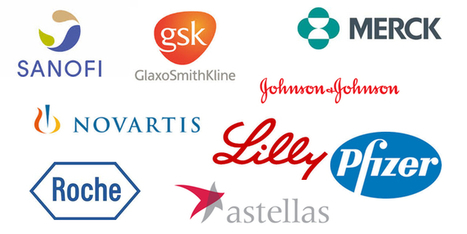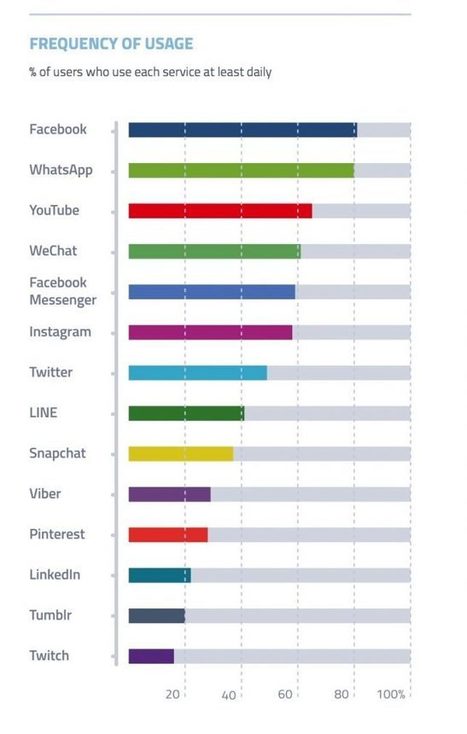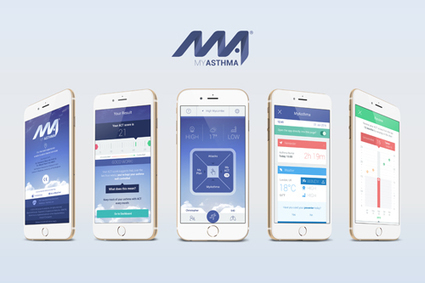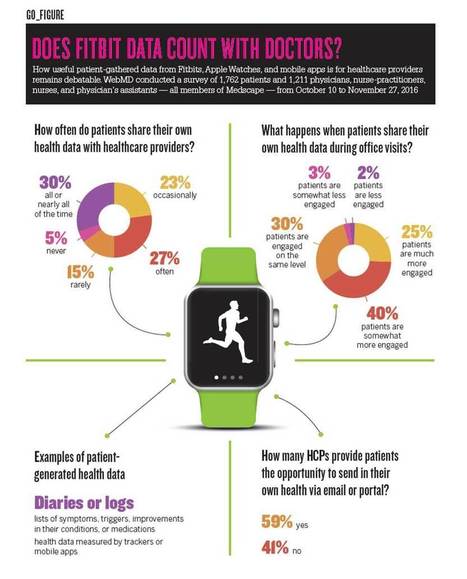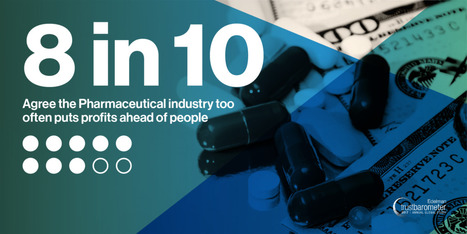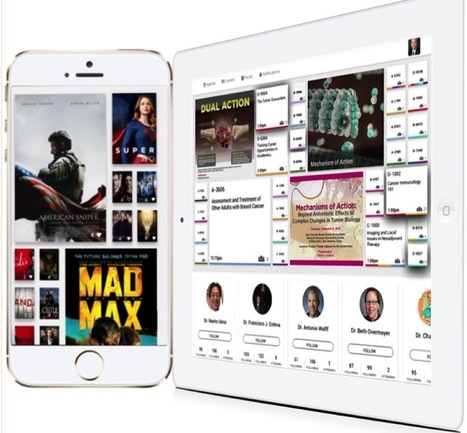 Your new post is loading...
 Your new post is loading...

|
Rescooped by
eMedToday
from #eHealthPromotion, #SaluteSocial
June 20, 2017 11:11 PM
|
The growth of social media in medicine, particularly oncology, has been impressive. The uses to date have varied from live reporting of meeting presentations to community development and support in any number of diseases. The American Society of Clinical Oncology (ASCO) 2015 Annual Meeting had over 74,000 tweets in the month surrounding the actual meeting dates, leading to over 330 million impressions. An "impression" is a tweet that has been delivered to a feed. To relate it to the statistic above, tweets from the ASCO annual meeting were delivered to over 330 million feeds. The 2016 American College of Cardiology conference has had over 31,000 tweets leading to over 197 million impressions. This is just a small sampling of all the information that comes out of conferences. Using social media for disease/treatment community development and support is also expanding. From dedicated Facebook pages to live Twitter chats, patients now interact with providers and advocates, often in real time. As I write this column, Symplur, a company that monitors and analyzes social media activity in medicine, reports 127 recurring Twitter chats in the upcoming week. Topics vary from rheumatoid arthritis, autism, and movement disorders to various malignancies, among many others. Now that social media has a firm foothold in medicine, it becomes reasonable to ask whether it is having any impact on patient care or outcomes. This question has been raised in any number of supportive activities in medicine. There are certainly reports that online support groups benefit patients,[1] but the definition of benefit has tended to be somewhat nebulous at best. The first question to ask is, what is an appropriate thing to measure? Now that social media has a firm foothold in medicine, it becomes reasonable to ask whether it is having any impact on patient care or outcomes. In oncology, our usual measured outcome is survival, although quality of life is often co-reported. Quality of life, however, is rarely the primary outcome looked at in any intervention. There have been suggestions that support groups can improve survival in breast cancer, but at least one randomized trial failed to show any impact on survival in breast cancer patients.[2] Is survival the only outcome that we should measure? Can we accept improvements in quality of life as an actionable outcome? What if we show that patients who are involved in social media communities are more likely to be compliant with their care or be more open to clinical trial participation? Would that information be persuasive enough to have granting organizations, institutions, and payers be more open to providing support and recognition to the physicians and support staff involved in these activities? Answering these questions will take a level of analysis and research that requires external support. To even get to the level of information and structure that granting organizations will be open to reviewing requires some firming up of ideas. There are physicians who are mulling these questions and starting down this path.[3] One such group in development is the Collaboration for Outcomes on Social Media in Oncology (COSMO). This group, of which I am a member, is looking at this with a blank slate, other than initially defining the best questions to ask. We have no hesitation—should the data point in this direction—saying that no positive impact can be determined by these efforts. We also have no problem saying that others may have thoughts on questions to be asked or approaches to take. In the spirit of crowdsourcing, we welcome any input. There are rumblings of an abstract to be presented at the next ASCO Annual Meeting suggesting improvement in survival with the use of patient navigators. Possibly the same could eventually be found with patient involvement in social media.
Via Plus91, Manav Chaudhary, Giuseppe Fattori

|
Rescooped by
eMedToday
from Pharma Hub
June 20, 2017 11:11 PM
|

|
Rescooped by
eMedToday
from Pharma Marketing
June 20, 2017 11:10 PM
|
Understanding health psychology creates a holistic view of health and medicine. Only then can pharma develop products that meet today’s complex health needs.
Via COUCH Medcomms

|
Rescooped by
eMedToday
from Pharma Hub
May 17, 2017 2:40 AM
|
Pfizer has made an online move into the fight against antimicrobial resistance with the launch of a new online and mobile information resource.
Via Philippe Marchal
KEY TAKEAWAY: GWI Social examined the very latest figures for social media engagement, social behaviors and trends within the social space. Among the key findings…filling up spare time is the main reason for using social media among 16-24s, while older groups see these platforms as a way to keep up with friends and the news. But is social media right for pharma? Almost every internet user can now be reached via social media – 94% of digital consumers aged 16-64 say they have an account on at least one social platform and 98% have visited/used one within the last month. So then, is social media a channel for pharma to reach patients?
Pfizer is using Facebook as an ad platform, but are men really going to click on the ad because Viagra now comes in individual dosage envelopes? Facebook has become a media rich RSS feed with users following interests and participating in social media activism via the share button. We can easily express outrage by simply sharing content we agree with but as facebook seems to know where we have been on the web and what we have done will “suggested post” health content become too intrusive?
In research, earlier this year, a lot of older facebook users were surprised to have suggested content appear in their facebook feed. A number of older women said they were offended and shocked that facebook seemed to know what health content they were researching online. So is social media right for pharma? In some cases, yes. At a minimum pharma should be listening to what patients are saying about their product as well as competitors’ products and using the input for content that addresses questions/concerns.
As for advertising on social media there are opportunities, but rather than advertise “single packs” perhaps Pfizer would do better to talk about men’s health as a way to engage the social media audience.
Via Plus91, Lionel Reichardt / le Pharmageek
GlaxoSmithKline mobile app that helps asthma patients better understand their condition and how to manage it was one of six winners at the AXA PPP Health Tech & You Awards.
MyAsthma, which was developed with UK agency The Earthworks, can track medicine usage and asthma attacks, and use location, weather and air quality data to learn what trigger’s a patient’s asthma.
An industry first, GSK’s app is the first from pharma has been approved as a Class 1 medical device and CE marked.
Via Alex Butler, Celine Sportisse

|
Scooped by
eMedToday
April 24, 2017 4:15 AM
|
Artificial intelligence algorithms are being taught to generate art, human voices, and even fiction stories all on their own—why not give them a shot at building new ways to treat disease? Atomwise, a San Francisco-based startup and Y Combinator alum, has built a system it calls AtomNet (pdf), which attempts to generate potential drugs for diseases like Ebol

|
Rescooped by
eMedToday
from #eHealthPromotion, #SaluteSocial
April 17, 2017 11:47 PM
|
You know you’ve been there. You want to find a new doctor or you’ve already selected a new doctor and you are seeing them for the first time. What do you do? You Google! Before we go any further, let me first suggest that you become a discerning Googler when it comes to healthcare. Many times, I end up having to dig deeper to page 2 or 3 or 4 on an online search to find substantial, credible information, and that’s crazy. Having to dig to page 3 or 4 to find the credible health information we seek is insane and poses a real problem for physicians and healthcare practices. Today I’m passing along a great podcast for those interested in healthcare social media. The podcast, “Doctor’s Reviews are In,” from Amazon #1 Best Selling Author, Daniel Lemin, tackles an interesting aspect of social media: online physician reviews. Mr. Lemin sat down with Dr. Kevin Pho, the premier expert and leading physician voice for all things healthcare social media. If you haven’t checked out his comprehensive encyclopedia of a blog, you must. He publishes four times a day. Wow. Inevitably, behemoth sites such as healthgrades.com and vitals.com come up first in any physician related online search. On these two sites, there is currently no requirement and no way to verify if a patient who writes a review has actually been seen by the physician they have reviewed. Healthgrades mentions they verify the person posting is not a spammer by “going through several validation steps,” such as confirming a reviewer’s email address. There is no mention of ability to confirm the patient actually saw the physician. I could not find an FAQ section on vitals. I looked for a few minutes. Either it’s not there or it is buried in some section of the website that is difficult to find, rendering it the same as not existing. There is at least one online review company that offers verified reviews. ZocDoc offers a number of pretty cool tools: ability to schedule appointments online, to store redundant, painful check-in paperwork, and to review physicians you have seen. Their website is pretty slick, and easy on the eyes. So what’s a physician to do? Rely on word of mouth? Ignore fake reviews? Continue to be incognito online? No! Today it is more important than ever for physicians to be proactive about building their online reputation. Dr. Pho eloquently points out that the practicing physician voice is almost totally missing from the online world. In addition, he stated that when a review is legitimate, studies suggest that most reviews are, in fact, positive! Having to dig to page 3 or 4 in a Google search to find the credible health information you seek is insane and poses a real problem for physicians and healthcare practices.
I like Dr. Pho’s recommendations to offset and manage a physician’s online reputation. Dr. Pho suggests taking a proactive, positive and creative approach to managing online reputations in healthcare. - Bring your ratings system in house. Bringing this feature “in-house” provides more control for a physician practice. The way I see it, there’s a number of ways to do this. One, form a relationship with a service like ZocDoc so that you ensure reviews are legitimate and ranked well in online searches. Two, have patients write testimonials that are mailed in to your practice and put online. Option two is probably not viable for most practices given the over paperworked, metric driven healthcare system that we exist in. Three, get an iPad for your practice so that patients can do a review at check out in the waiting room. Your IT guy can upload them to your website as featured testimonials. Sure, it’s not a “usual” thing to do, and without a doubt, someone in the practice will complain that it’s too cumbersome or causes them too much extra work. However, I would argue losing business to a poor online brand and fake reviews is a worse idea. For the right practice that has a champion to own this process and is committed to improving their online brand, this could actually be a very easy thing to do.
- At a minimum, set up a LinkedIn profile. Come on, docs! This one is so easy. It takes less than 20 minutes to set up a bare bones LinkedIn profile. Setting up a LinkedIn profile creates an online resume, provides you a public image online and lends you the power of LinkedIn’s search engine optimization. Having the power of LinkedIn’s SEO is important, given that the unverified review sites have excellent SEO and often outrank physician’s own websites when their name is googled. Don’t have the time to make your profile or want to be trained on how to manage your social profiles? Contact me. It’s painless. I promise.
- Consider joining HCP only social media sites like Doximity and SERMO. Again, creating a Doximity or SERMO profile puts some powerful SEO behind your name, and connects you with a vast HCP network. Currently 500,000 physicians are members of Doximity. Doximity also has a neat feature that allows HCPs to send and receive secure, HIPAA compliant faxes right from a mobile device. SERMO is the largest, global HCP-only social networking site with over 600,000 physician members. It features such benefits as medical crowdsourcing for complex cases and confidential real world healthcare discussions.
There was so much fantastic information covered in the podcast. I suggest taking a listen for yourself. The podcast is available on Manipurated.com, here. View my recommendations for additional ideas to start building an online brand in my previous post, “A lesson in personal branding: hiding online is no longer an option. Taking a proactive approach to managing online reputation in healthcare will increasingly become important as patient satisfaction scores are already starting to drive reimbursement from payers. Furthermore, patients are demanding a better service experience from their healthcare providers as healthcare costs are now frequently pushed down to the patient in the form of higher co-pays/co-insurance, consumer driven healthcare plans with high deductibles, and rising chronic disease epidemics. Dr. Pho points out that healthcare tends to lag a few years behind the newest trends. Now that most of us can’t even eat at a restaurant without “Yelping” it first, I think it is safe to say, we are almost there with healthcare. I for one, am excited to see what the “Yelp” of healthcare will be!
Via Plus91, Giuseppe Fattori
Despite the fact that social media has had a significant impact on the way that people communicate with each other and has been adopted globally by every kind …
Via Plus91, Lionel Reichardt / le Pharmageek

|
Rescooped by
eMedToday
from Pharma Hub
April 17, 2017 11:45 PM
|
Pharma marketers continued to up their social media game in 2016, according to a new report, with many embracing disease awareness and charitable causes to drive engagement across social networks.
Via Plus91, Philippe Marchal

|
Rescooped by
eMedToday
from PATIENT EMPOWERMENT & E-PATIENT
April 10, 2017 2:20 AM
|

|
Rescooped by
eMedToday
from #eHealthPromotion, #SaluteSocial
April 10, 2017 2:16 AM
|
Operating extensively within the digital healthcare industry, both as a startup, as well as a digital marketing agency supporting global pharmaceutical companies has taught us that both have a need that the other can readily offer. As pharma and consumer healthcare companies are quickly realising, the future of healthcare lies in the technologies of tomorrow. For digital healthcare startups on the other hand, the opportunities to see their dreams realised have never been more exciting. So, how and why can both the pharma company and the startup make positive headway here.
Via Giuseppe Fattori
|

|
Rescooped by
eMedToday
from #eHealthPromotion, #SaluteSocial
June 20, 2017 11:11 PM
|
Measuring influence – how we used the Healthcare Social Graph® Score to determine PM Society’s Digital Awards winner. The PM Society’s 2016 Digital Awards took place last month in London, and we were again asked to do the analysis and present the winner of the Social Media Pharma Company of the Year award. In order for a company to have an effective social media presence it must know where the relevant conversations are taking place, the style of messaging that resonates among the participants, and most importantly who the influencers are within those networks of individuals. We used the Healthcare Social Graph® algorithm to determine whether a company was able to reach their audience from engaging key opinion leaders and their spheres of influence. The five companies shortlisted for the award were AbbVie, Bayer, Boehringer, Novartis and Pfizer. Symplur partner Josh Lurie was there in London to present the award to the winner. But before we get to the winner, let’s walk through how we computed the data. From the 606 million healthcare tweets collected during 2015 we analyzed the conversations around the top 10 diseases with the highest mortality rates in the U.K.; Breast Cancer, Lung Cancer, Prostate Cancer, Stroke, Dementia and Alzheimer’s Disease, COPD, Heart disease/failure, Lymphoma, Bowel Cancer and Pneumonia. Over 500 different hashtags were part of the dataset covering these 10 diseases. The pharma accounts with the highest influence and engagement were identified by the Healthcare Social Graph Score. We track many different types of pharma Twitter accounts; corporate accounts, disease specific, drug specific, geographically specific, and various communication campaign accounts which total over 500 accounts from dozens of companies. Healthcare Social Graph ScoreThis score is powered by a proprietary algorithm that recursively measures everyone’s influence and who they are engaging with. Not every interaction is equal. A mention from an account not known to be influential in healthcare or influential in the health topic at hand is heavily discounted, while mentions from engaged Doctors, Patients, Caregivers, Government accounts etc., or accounts identified as influential in the specific disease are given more importance.
Via Giuseppe Fattori

|
Rescooped by
eMedToday
from Pharma & Medical Devices
June 20, 2017 11:10 PM
|
The drug industry is worried that Congress may seek to eliminate its tax break for advertising costs, which would amount to a $50 billion hit over a decade.
Via Richard Meyer
DRG Digital - Manhattan Research's Taking the Pulse® U.S. 2017 study asked 2,784 U.S. physicians across 25+ specialties about their use of emerging technology, how they find information and make decisions, and what they want from pharma companies. The aim of the study is to help marketers refocus their digital efforts on what works and plan more effective multichannel campaigns.
Lead analyst Kelly Pinola comments, "Pharma needs to dial down the promotional messaging and lead with valuable educational resources in order to regain physician trust. The good news for pharmas is that there’s an opportunity here for them to differentiate themselves as truly user-centered organizations, since this is a problem we’re seeing across the industry.”
Three key findings for marketers are highlighted in the infographic.
Via Pharma Guy, Lionel Reichardt / le Pharmageek

|
Rescooped by
eMedToday
from Pharma Hub
May 17, 2017 2:39 AM
|
Healthcare company Abbott has announced that its smartphone compatible Confirm Insertable Cardiac Monitor (ICM) has gained CE Mark approval. The device is intended to help physicians recognise cardiac arrhythmias which are difficult to detect such as atrial fibrillation.
Via Philippe Marchal
The 2017 Edelman Trust Barometer paints a sobering picture of the state of trust around the world…[but] the healthcare industry is making slow but steady progress. Trust in healthcare, as well as in all five subsectors of healthcare we study (pharmaceutical/drug companies, consumer health/over the counter, biotech/life sciences, insurance and hospitals/clinics), is actually on the rise, gaining momentum from last year and reversing a backwards trend we saw last year for pharma (globally and in the U.S.) and biotech (in the U.S. only). Pharma may be up four points in the U.S., but that gives it a score of just 51, squeaking into the “neutral” range by only one point. [Meanwhile: “Pharma Industry Reputation Hits 7-Year Low According to Harris Poll”; http://sco.lt/9ACnPV This poll finds only 29% of U.S. consumers think “positively” of the pharma industry.] Pharma in particular continues to face headwinds, with the Trust Barometer showing that globally: - Approximately 8 in 10 people (82 percent) believe the government needs to do more to regulate the pharmaceutical industry; and
- 8 in 10 people (80 percent) believe that the pharmaceutical industry puts profits over people.
Further Reading:
Via Pharma Guy, Lionel Reichardt / le Pharmageek
Clinicians are people – just like us. Like us, most of them are busy, have friends and start their day on social media. In just the last two years, our media habits changed dramatically and there a…
Via Richard Meyer, Lionel Reichardt / le Pharmageek

|
Scooped by
eMedToday
April 17, 2017 11:45 PM
|
Click here to edit the content

|
Rescooped by
eMedToday
from Pharma Hub
April 17, 2017 11:44 PM
|
What if an app could replace a pill? That’s the big question behind an emerging trend known as “digital therapeutics.” The idea: software that can improve a person’s health as much as a drug can, but without the same cost and side-effects.
Via Giuseppe Fattori, Philippe Marchal

|
Rescooped by
eMedToday
from Pharma Hub
April 10, 2017 2:18 AM
|
|



 Your new post is loading...
Your new post is loading...



